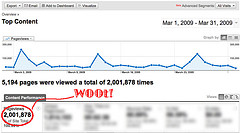In Part 1 of this series, I described exactly how I designed an experiment to test (at minimum risk) whether or not it is possible to recycle a blog post without hurting SEO (search engine optimization). That is, I was interested in finding out whether or not Google would notice and apply the dreaded duplicate content penalty if I carefully recycled content that had been published earlier.
One lesson learned
The blog post I selected for the recycling experiment was not in the top 50% of our blog in terms of popularity. This first test told me that more testing with popular blog posts will be needed to substantiate any conclusions. One thing is certain already however, and that is that carefully recycling some blog posts can be done without harming the popularity or traffic of the blog itself. The old version of the blog post tested had very few pageviews over 2 years. The recycled post has nearly as many pageviews in only 3 months. This increased rate of pageviews is almost entirely attributable to the overall increase in traffic on our blog between the time of the original post and the recycled post two years later.
Quantity versus quality
Looking closer at the pageviews of the recycled post to see where (geographically) our visitors are coming from, I can see that the additional traffic is not necessarily something to celebrate. The majority of the new visitors are outside our geographically targeted service area, so this raises the question of whether or not the quality of the post title or certain blog post topics are more important factors than the content itself.
Test number two
For a second recycled blog post test, I chose one that was more popular. This post was above the median for pageviews over 2 years with solid percentage of those pageviews in our prime geographic target area. (I don’t mean to imply that volume and geography are the only factors to consider, but focusing on those two basic data points keeps our little experiment manageable.) The new post went up early last month, so it’s a little too soon to tell. We can compare apples to apples and look at both of them for the first month and see that once again the new post is out pacing the old one by more than 25%, but the geographic targeting has decreased. Again, it’s too early to tell on this test, but so far the similarities are interesting.
To continue following this cliff hanger for nerds, be sure to subscribe above so you don’t miss the final results.





Can You Recycle a Blog Post Without Hurting SEO? Part 2 | Change Conversations http://t.co/h0zRpdKu